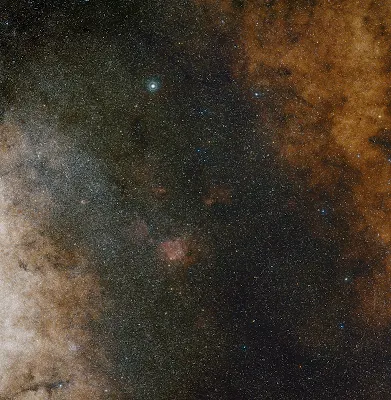Οι
επιστήμονες παρατήρησαν το μοτίβο κίνησης ενός άστρου γύρω από την κεντρική
μαύρη τρύπα, γνωστή ως «Τοξότης Α*» ή Sgr*, που έχει τέσσερα εκατομμύρια φορές μεγαλύτερη μάζα από τον
Ήλιο, από τον οποίον απέχει 26.000 έτη φωτός. Η τροχιά του άστρου συμφωνεί με
τις προβλέψεις που βασίζονται στη γενική θεωρία της σχετικότητας του Άλμπερτ
Αϊνστάιν. Observations made with ESO’s Very Large Telescope
(VLT) have revealed for the first time that a star orbiting the supermassive
black hole at the centre of the Milky Way moves just as predicted by Einstein’s
theory of general relativity. Its orbit is shaped like a rosette and not like
an ellipse as predicted by Newton's theory of gravity. This effect, known as
Schwarzschild precession, had never before been measured for a star around a
supermassive black hole. This artist’s impression illustrates the precession of
the star’s orbit, with the effect exaggerated for easier visualisation. Credit: ESO/L.
Calçada
Οι
μακρόχρονες παρατηρήσεις του Πολύ Μεγάλου Τηλεσκοπίου (VLT) του Ευρωπαϊκού Νοτίου Αστεροσκοπείου (ESO) στην έρημο Ατακάμα της Χιλής αποκάλυψαν
πρώτη φορά το «χορό» ενός άστρου γύρω από την τεράστια μαύρη τρύπα στο κέντρο
του γαλαξία μας.
ESO's Very Large
Telescope has observed a star dancing around the supermassive black hole at the
centre of the Milky Way. The observations have revealed, for the first time,
that the star’s orbit is shaped like a rosette and not like an ellipse. Credit: ESO
Η
τροχιά του άστρου συμφωνεί με τις προβλέψεις που βασίζονται στη γενική θεωρία
της σχετικότητας του Άλμπερτ Αϊνστάιν.
Είχαν
προηγηθεί παρατηρήσεις του συγκεκριμένου άστρου και μετρήσεις της κίνησής του
που κράτησαν 27 χρόνια, μέχρι οι ερευνητές από διάφορες χώρες (Γερμανία,
Γαλλία, Πορτογαλία), με επικεφαλής τον Ράινχαρντ Γκέντσελ, διευθυντή του
γερμανικού Ινστιτούτου Εξωγήινης Φυσικής Μαξ Πλανκ, να κάνουν τη σχετική
δημοσίευση στο περιοδικό αστρονομίας και αστροφυσικής Astronomy & Astrophysics.
Το
VLT συνδυάζει σε ένα
ενιαίο υπερ-τηλεσκόπιο το φως τεσσάρων επιμέρους τηλεσκοπίων διαμέτρου οκτώ
μέτρων το καθένα, αποκτώντας έτσι ανάλυση ισοδύναμη ενός τηλεσκοπίου με
κάτοπτρο διαμέτρου 130 μέτρων.
Η
πρώτη επιβεβαίωση της θεωρίας του Αϊνστάιν είχε γίνει μέσω παρατήρησης της
τροχιάς του Ερμή γύρω από τον Ήλιο.
This visible light
wide-field view shows the rich star clouds in the constellation of Sagittarius
(the Archer) in the direction of the centre of our Milky Way galaxy. The entire
image is filled with vast numbers of stars — but far more remain hidden behind
clouds of dust and are only revealed in infrared images. This view was created
from photographs in red and blue light and forming part of the Digitized Sky
Survey 2. The field of view is approximately 3.5 degrees x 3.6 degrees. Credit: ESO and Digitized Sky Survey 2.
Acknowledgment: Davide De Martin and S. Guisard (www.eso.org/~sguisard)
Τώρα,
ύστερα από περίπου 100 χρόνια, οι επιστήμονες παρατήρησαν το ίδιο μοτίβο
κίνησης ενός άστρου γύρω από την κεντρική μαύρη τρύπα, γνωστή ως «Τοξότης Α*» ή
Sgr*, που έχει τέσσερα
εκατομμύρια φορές μεγαλύτερη μάζα από τον Ήλιο, από τον οποίον απέχει 26.000
έτη φωτός.
This simulation shows the orbits of stars very close to the supermassive black hole at the heart of the Milky Way. One of these stars, named S2, orbits every 16 years and is passing very close to the black hole in May 2018. This is a perfect laboratory to test gravitational physics and specifically Einstein's general theory of relativity. Research into S2's orbit was presented in a paper entitled “Detection of the Gravitational Redshift in the Orbit of the Star S2 near the Galactic Centre Massive Black Hole“, by the GRAVITY Collaboration, which appeared in the journal Astronomy & Astrophysics on 26 July 2018. Credit: ESO/L. Calçada/spaceengine.org
Γύρω από την κεντρική μαύρη τρύπα υπάρχουν πολλά άστρα. Ένα από αυτά είναι το S2, που κινείται σε απόσταση έως 20 δισεκατομμύρια χιλιόμετρα από αυτήν (περίπου 120 φορές η απόσταση μεταξύ Γης και Ήλιου).
Observations made
with ESO’s Very Large Telescope (VLT) have revealed for the first time that a
star, S2, orbiting the supermassive black hole at the centre of the Milky Way
moves just as predicted by Einstein’s theory of general relativity. Most stars
and planets have a non-circular orbit and therefore move closer and further
away from the object they are rotating around. S2’s orbit precesses, meaning
that the location of its closest point to the supermassive black hole changes
with each turn, such that the next orbit is rotated with regard to the previous
one, creating a rosette shape. This effect, known as Schwarzschild precession,
had never before been measured for a star around a supermassive black hole. This
animation shows S2’s orbit around Sagitarius A*, the supermassive black hole at
the centre of the Milky Way. The precession movement is exaggerated for easier
viewing. Credit: ESO/L. Calçada
This time-lapse
view shows images from the GRAVITY instrument on ESO's Very Large Telescope as
it tracks the progress of the star S2 as it made a close passage past the black
hole at the centre of the Milky Way in May 2018. Credit: ESO/GRAVITY
Collaboration
Κατά
την κοντινότερη διέλευσή του, το άστρο, υπό τη βαρυτική επίδραση της μαύρης
τρύπας, κινείται με ταχύτητα σχεδόν 3% της ταχύτητας του φωτός, ολοκληρώνοντας
μία περιφορά κάθε 16 χρόνια.
Τα
περισσότερα άστρα και οι πλανήτες δεν ακολουθούν κυκλική τροχιά, αλλά πότε
πλησιάζουν και πότε απομακρύνονται από το αντικείμενο γύρω από το οποίο
περιστρέφονται.
Η
γενική θεωρία της σχετικότητας παρέχει μια ακριβή πρόβλεψη τού πώς αλλάζει η
τροχιά λόγω της λεγόμενης «μετάπτωσης Schwarzschild», ενός φαινομένου που δεν είχε μετρηθεί
ποτέ έως τώρα για ένα άστρο πέριξ μίας μαύρης τρύπας.
Πηγές: https://www.eso.org/public/archives/releases/sciencepapers/eso2006/eso2006a.pdf - https://www.eso.org/public/news/eso2006/ - https://www.tovima.gr/2020/04/16/science/o-xoros-enos-astrou-gyro-apo-tin-kentriki-mayri-trypa-tou-galaksia-mas/




Δεν υπάρχουν σχόλια:
Δημοσίευση σχολίου